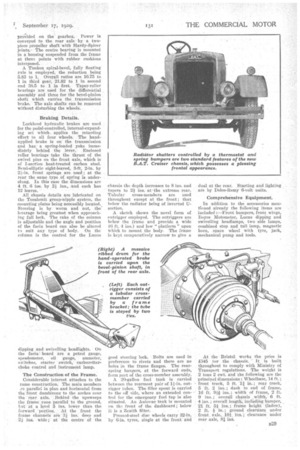AN ENTIRELY NEW 20-SEATER Passenger Chassis
Page 62

Page 63

If you've noticed an error in this article please click here to report it so we can fix it.
FOR many years Harris and Hase11, Ltd., 24, St. George's Road, Bristol, and 79, Pentonvilie Road, London, N.1, has beaa known as a concessionnaire for commercial chassis. Now the company is launching out as a manufacturer, the first type being designated the Cruiser. It is intended for carrying 2b-seater bodies, the gross load not exceeding 2 tons 10 cwt. Another machine which Will appear shortly is a 32-seater with an in-line eight-cylindered engine.
A six-cylindered Continental engine is three-point suspended in the frame of
the Cruiser, a trunnion being used at the front and brackets at the rear, all with rubber cushions interposed. The bore and stroke are n ins. and 4 ins. respectively (3,517 c.c.) and the R.A.C. rating is 27.3 h.p. At 2,600 r.p.m.
the output is 59 b.h p. The cylinders are cast en bloc with the crankcase and the cylinder head is detachable.
Engine details include fourring aluminium pistons, seven bearing balanced crankshaft, steel connecting rods, side-by-side valves, chain-driven camshaft, pressure lubrication by geartype pump, Delco-Remy coil ignition, manual and semi-automatic ignition control, Zenith pump-type carburetter, hot-spot induction, belt-driven fan and pump assembly and radiator shatters controlled by a thermostat. The radiator has a separate nickel shell and is carried upon rubber cushions.
Mounted in unit with the engine is the four-speed gearbox with central control. The clutch is a dry singleplate, and a mechanical tyre pump is
provided on the gearbox. Power is conveyed to the rear axle by a twopiece propeller shaft with FIardy-Spicer jeinta.The centre bearing is mounted in a housing suspended from the frame at three points with rubber clishions interposed.
A Timken spiral-bevel, fully floating axle is employed, the reduction . being 5.83 to 1. Overall ratios are 10.75 to 1 in third gear, 21.82 to. 1 in second and 38.5 to. 1 in first. Taper-railer bearings are used for the differential assembly and three for •the bevel-pinion shaft which carries the transmission brake. The axle shafts can be removed without disturbing the wheels. ..
Braking Details.
Lockheed hydraulic brakes are used for the pedal-controlled, internal-expanding set which. applies the retarding effort to all four wheels. The handapplied brake is on' the transmission and liar,' a spring-loaded yoke immediately 'behind the lever. Enclosed roller bearings take the thrust of the swivel pins on the front axle, which is of 1-section heat-treated carbon steel. Semi-elliptic eight-leaved, 3-ft. 2-in. by 2•1:-in. front springs are used ; at the rear the same type of spring is underslung. In this case the dimensions are 4 ft. 6 ins. by 2i ins., and each has 12 leaves.
All chassis details are lubricated on the Tecalemit group-nipple system, the mounting plates being accessibly located. Steering is by worm and nut, the leverage being greatest when approaching full lock. The rake of the column is adjustable and the angle and position of the facia board can also be altered to suit any type of body. On the column is the control for the Lucas dipping and swivelling headlights. On the facia board are a petrol gauge, speedometer, oil gauge, ammeter, switches, starter switch, earbnretterchoke control and instrument lamp.
The Construction of the Frame.
Considerable interest attaches to the rame construction: The main members .re parallel in plan and horizontal from the front dumbirons to the arches over the rear axle. Behind the upsweeps the frame runs parallel to the ground, but at a level 5 ins, lower than the forward 'portion. At the front the frame channels are 3i ins, deep and
21 ins. wide; at centre of the chassis the depth increases to 8 ins, and tapers to 2 ins: at-the extreme rear. Tubular cross-members are used throughout except at the front ; that below the radiator being of inverted Usection.
A .sketch shows the novel form of outrigger employed. The outriggers are below the frame and provide a wide (6 ft. 4 ins.) and low " platform " upon which to mount the body. The frame is kept comparatively narrow to give a good steering lock. Bolts are used in preference to rivets and there are no holes in the frame flanges. The rearspring hangers, at the forward ends, form part of the cross-member assembly.
A 20-gallon fuel tank is carried between the rearmost pair of 14-in. outrigger tubes. The filler spout is carried to the off side, where an extended Control for the emergency fuel tap is also situated. An Autovac tank ismounted on the front of the dashboard; below
it is a 'zenith filter. . • Pressed-steel disc wheels carry 32-in. by 6-in. tyres, single at the front and dual at the rear. Starting and lighting are by Delco-Remy 6-volt units.
Comprehensive Equipment.
In addition to -the accessories mentioned already the following items are included :—Front bumpers, front wings, Boyce Motometer, Lucas dipping and swivelling headlamps, two side lamps, combined stop and tail lamp, magnetic horn spare wheel with tyre, jack, mechanical pump and tools.
At the Bristol works the price is k545 tor the chassis. It is built throughout to comply with Ministry of Transport regulations. The weight is 2 tons 2 cwt. and the following are the principal dimensiona : Wheelbase, 14 it.; front track, 5 ft. I in.; rear track, 5 ft. 2 ins.; dash to end of frame, 16 ft. 944 ins.; width of frame, '2 ft. 9 ins.; overall chassis ,WWO, 6 ft. 4 ills,; overall length, including bumper, 21 ft. 51 ins. ; frame height (laden):
2 ft. in.; ground cleaMnce. under front. axle, 10/ ins.; clearance under rear axle, 81 ins.




















































































































